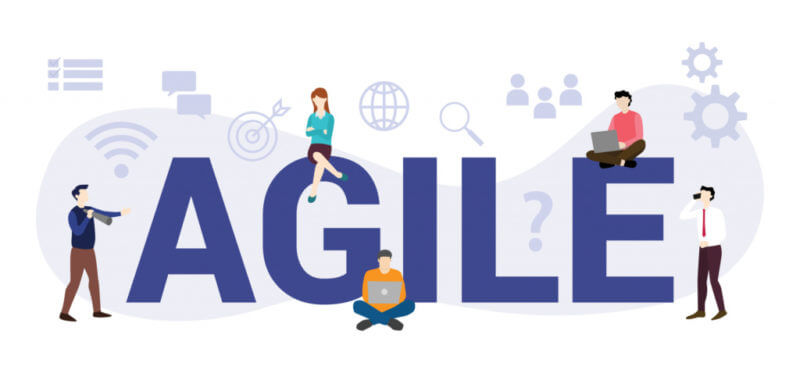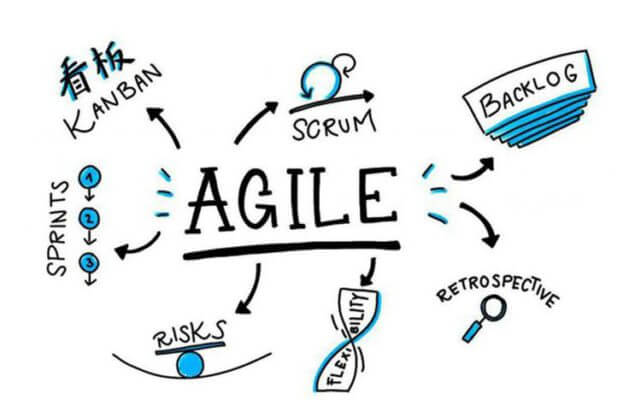If you’re interested in how to build an Agile team, this article is perfect for you.
Creating good software apps helps your company to maintain and thrive. A well-controlled process is the only way to guarantee a good product.
The agile team will help you develop an app effectively. But first, what is Agile?
What is Agile?

Agile is a flexible software development method and project management that delivers products to users the fastest with minimal problems. Instead of risking on a one-time product release after everything is done, the Agile team will release one piece at a time but are guaranteed to be usable. All the requirements, plans, and outcomes are evaluated continuously so the development team can change quickly to suit reality.
How did Agile get started?
Before the 1990s of the 20th century, there was a crisis in software development methodology globally. This crisis was many weaknesses in the traditional methods and a high rate of project failure. Many individuals and private companies have self-discovered and developed many methods to adjust to new situations, where the business environment’s factors and technology change rapidly, causing traditional development methods to be no longer suitable. These individual methods partly solve some problems but create other problems of sharing, collaboration, techniques, tools, extensions, development directions, etc.
That’s why, in February 2001, seventeen developers who represented the new development method met in Utah to establish the document called Agile Manifesto with 12 principles thanks to consensus in methods. This was the time the Agile terminology used widely nowadays. Even individual methods have existed before.
Roles in the Agile Method
User: Clear target audience begins the process. By defining the exact users’ characteristics, those functions help build all the multiple standards/requirements in the workflow that software supports.
Product Owner: Are the main stakeholders or the main users of the soon-to-be-developed app. A product owner is a representative of the customers and the final authority. They’re always ready when anyone has any doubts that need clarification. The most important thing that the Product Owner needs to understand is no requirement addition between the sprint phase or the beginning of the sprint.
Software development team: In Agile, programmers are involved in developing specific functions. They can have different skills, and some even are good at certain skills.
Moreover, the Software development team includes quality assurance engineers (QA) and other programmers (such as databases and backend systems), designers, and analysts, which depends on the type of project.
Agile Methods (Agile Frameworks)

Scrum
The most common and widely used Agile Framework is Scrum, a management and control process applied in software development projects. It helps eliminate all the workflow’s complexity and focuses only on the necessary steps to meet the customers’ needs. Scrum can be considered a Framework or a set of practices for being applied in software development.
Scrum was established in the 90s and currently is considered an effective Framework and used widely between many small and big companies. Scrum’s feature is simple and easy to apply.
Scrum incorporates a distribution rhythm called a Sprint (a repeating phrase of a Scrum). Sprints last from a week to a month and continue to keep projects progressing as fast as possible. Four key events happen in each sprint.
- Makes plans to determine the sprint priorities.
- Daily Scrum Calls/Meetings – Development Team has a meeting for 15 minutes/day to track the team’s progress against the sprint goals and identify blockers.
- Sprint Review – Development Team collaborates and exchanges opinions/views on completed tasks and adjusts backlog as required.
- Sprint Retrospective – This is a great learning experience for the Development Team. The group discusses openly key items that have been successful and cases where the group fails to meet expectations to improve things for the future.
Also, several Frameworks can perform Agile, such as Kanban.
Kanban
Kanban is an intuitive system for managing the work that happens in a pre-built process. Kanban visualizes the workflow and accurately reflects the actual work execution status based on that process. Kanban’s goal is to define the work that needs to be done and how it is to be done so that production can run efficiently at maximum speed and quality.
“Kanban is a terminology originating from Toyota car company used in manufacturing and engineering in the 40s. An industrial engineer at Toyota, Taiichi Ohno, developed kanban to improve production efficiency. According to Japanese, Kaban means a visual card, with the word “kan” for sight and the word “ban” as a tag. Leaders have used these Kanban cards to remind their employees what to do with the process.”
Some benefits in Kanban applications:
- Continuous delivery
- Flexible
- Shorter lead time
- Fewer bottlenecks
- Data visualization
- Continuous delivery
Kanban Broads are powerful tools for a regular daily meeting with Agile Development Team, and it has five rigids:
- Backlog
- To-do
- In progress
- Review
- Done
Development management teams will deliver Kanban cards from this rigid to that rigid after the task completion. This visualization helps to identify roadblocks and establish the right approach for missions quickly. When teams gather together during daily meetings, there is better free-flow and interaction, etc.
Extreme Programming (XP)
XP (Extreme Programming) is a software development method aiming to improve the software qualities and the responsiveness with the user requirement change. XP is one of Agile’s methods that advocates making releases regularly through short development cycles to improve productivity and create times for taking in new user requests. The author of XP is Ken Beck, an American software engineer.
XP focuses on the best use of programming techniques, clear communication, and teamwork to create the best products. Some XP’s components and functions are Pair Programming, Review Code, Unit Test, Keep Source Code Simple and Clear, Be Ready for Change, Communicate regularly with customers, switch between developers regularly.
Which environment is suitable for using Extreme Programming (XP)?
- Constantly changing software requirements.
- The risk associated with fixed time projects using new technology
- The scale of the Agile Development Team is small and arranged separately
- The technology used allows for automated unit and function testing
The five core values of XP
Communication: members of the teams communicate directly daily from requirement analysis to programming.
Simplicity: just working on the necessity. Do what is necessary for the present, not the future too far, with small steps to reach the goal and minimize mistakes.
Feedback: ensuring strictly to deliver the best software in the short iteration continually. It is always possible to demo good software early and often listen to the parties’ feedback and make necessary adjustments.
Respect: people feel and are respected for themselves as important members of the team. Everyone plays a role in creating value, no matter how the work is.
Courage: always be right about progress and estimates. There is no need to be afraid because members don’t work alone. Every time there is a change, the group will take the necessary actions to adapt. Courage in throwing away what is not needed anymore (source code, papers, etc.)
Like other agile development methods, “Extreme Programming” focuses on customer participation, consistent and fast response mechanisms, continuous planning and testing, effective collaboration, and work. To provide software at regular intervals. XP focuses on teamwork. Managers, developers, and customers are all equal partners. It implements a simple yet efficient environment, allowing the team to be highly efficient. The team solves the problem itself as efficiently as possible.
XP uses 12 practices used in software development, including:
- The Planning Game
- Small releases
- System Metaphor
- Simple design
- Testing
- Refactoring
- Pair programming
- Collective ownership
- Continuous integration
- Working 40 hours a week
- On-site customer
- Coding standards